
After years of practicing SEO, you might be thinking that you have mastered and understood What is SEO(Search Engine Optimization), but let me inform you that International SEO is entirely different.
You’ll need to master the skill to plan your business to place it from domestic to international platforms.
Level up and avoid the traps with this comprehensive guide to International SEO. It will give you a better understanding of what works in Global SEO, as the strategies in your region or country would probably not work well for your Global platforms.
But before you know more about the term International SEO, you need to know “The concept of Internationalization.”
As you would have noticed, the word International SEO on the internet talks mainly about decision-making and the technical aspects of making your website/business stand out internationally.
But that’s not enough; it also helps you to understand the global competitiveness issues, which allows you to plan better marketing strategies and analyze the competition before expanding your operation.
But before continuing, you should breathe for a second. This abrupt pause is because we are going to discuss some terms that we cannot afford to be ignored by you, such as global competitiveness and Internationalization.
According to AFI, “ The companies that internationalize, regardless of their size, are not only more competitive but also more productive and are more resistant to micro and macroeconomic changes, in comparison with companies that don’t.”
It’s clear that Internationalization is a great opportunity and advantage for your business, and that is why, if you take the internet as an ally, it opens up various opportunities for you to break through the boundaries of barriers.
What is International SEO, and Why is it necessary to go international?
The websites and their content that is optimized for search engines like Google and Bing through a technique called SEO (Search Engine Optimization), but the Goal of International SEO is to increase the website’s organic traffic from multiple geographical regions and linguistic groups, which is multiregional SEO and multilingual SEO.
It helps searchers to allow search engines of different countries to find your site quickly.
But you might be thinking that to be on an international platform is a challenging task: it comes with risk and uncertainty and is also more costly than Local SEO.
So, what is the advantage of doing International SEO?
At first sight, there is none, but after great efforts, come up with the best rewards. If you are already completely sure that this is the right way and best decision to go, this would be the reason that will support your decision.
- To get the desired growth and result
- Be ahead in the Competition
- Diversifying the market
Difference between International SEO and Local SEO
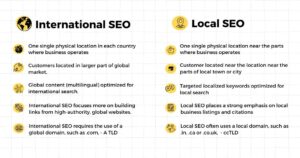
One of the biggest differences between local and international SEO is scale. Local SEO is focused on keywords and target audiences within a narrow geographic area, while international SEO targets diverse geographical areas.
The primary differentiators between Local SEO and International SEO are:
- Content
To ensure the International SEO strategy reaches your website, you need to create more significant content than you would do for a local SEO strategy.
- Competition
Competition is much greater for International SEO rather than Local SEO Efforts for keywords and even customers. Instead of simply competing with other businesses in the same local sphere, you could come up against multinational corporations.
- Cost
Owing to scale and scope, international SEO efforts come with significant costs.
- Target
The target market of International SEO expands more than you’re trying to capture, which needs in-depth research to ensure your brand alignment with customer expectations.
Principles for International SEO.
When we speak about the International SEO principles, we refer to some of the fundamental aspects that are considered imperative. So, if you‘re clearly interested in taking and connecting with new countries through the internet, this is what you should know:
- Keywords between the regions.
- Original and Quality content across different countries.
- Mobile-friendly website.
- Hreflang attributes.
- Track and Analyze your results.
-
Keywords between the Regions.
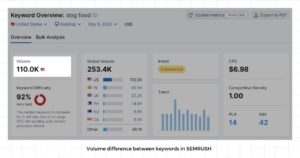
You do follow this exercise: Google your country using an anonymous window. Each country has its specific Google domain; for example, If your country is the United States, then “Google.us” is your country’s domain.
Then, take one of your keywords and search for them with two different domains.
Very often, the same content with the same keywords will be found in different places.
But sometimes the position changes. Why is it? There are many factors that are responsible, like the traffic of keywords, the relevance of keywords in each country, and lastly, the way users search.
If you look at our example, the search volume for the Keyword is different in different areas because it is likely that people don’t exactly look for the term “Search Engine.” Therefore, the volume search is different from other areas.
As each region of the Globe has its own Expression, Language Structure, vocabulary and different information needs. That’s why content designed for your local audience would not always be relevant to the audience of other countries you want to reach.
TIP: if your business is designing content in a second language, try not only to translate the relevant keywords but also think about how people search for certain terms, as the searching habits will always be different, no matter where.
How to search:
- Start by searching on Google. X for the region you want to target and reach.
- Use this space to perform deep crawling regarding the user’s keywords that are relevant to your business.
- Observe how they address it in the country you are targeting and look at how they work on each term.
-
Original and Quality content across different countries.
No matter how much we talk about International SEO, original and quality content is important, and this continues to be the same rule that applies to even basic SEO.
The original and quality content continues to succeed!
If you keep your eyes peeled for your local strategy, it is possible to identify what your buyer audience considers to be quality content.
You can even use tools like Google Trends to see the subjects that may be important for you to cover at a time in your content. Always remember to compare what your competitors are doing and identify their weaknesses and opportunities to rank.
Now, have you ever thought, after having so much information just from the region you want to target, imagine what it’s like to do a quality and organic search in other countries?
That is where the International SEO charm comes from more countries, more analysis, more points of comparison, and more information to combine and create quality and original content.
-
Mobile-friendly website.
This is the undeniable trend of searching in today’s digital world. The trend of search and browsing is always prioritized in any created content.
Just like Local SEO, Right?
If you want Google to prioritize Mobile-friendly content, your site needs to be performing well and offer good user experience and usability on different devices.
So make sure you have your site mobile-friendly and serve better usability and user experience.
-
Hreflang attributes.
Do not forget the Hreflang Attribute.
This is the term that allows you to distinguish between local SEO and International SEO. Hreflang attributes allow Google to identify the URL that should be shown to the visitors based on their language and geographical location.
Whenever you access the website, it automatically directs you to the right page of the site. To apply this indispensable tag, you can take the Google Guide.
-
Track and Analyze your results.
As with any Digital marketing strategy, including any SEO technique, tracking and analyzing the results is important.
To track and analyze your results, you need to create an SEO report. Here are Points to be Considered for creating your SEO Report.
In International SEO, you must also keep your eye on each and every move, as any event in your region or anywhere in the world will directly affect and reflect on your results.
And if you maintain consistency with Tracking and analyzing, improving, and fixing all the errors, this is a premise that you will always be included.
So take your time, crawl deep, and analyze deep into the subject!
Most Common obstacles that come in the way of International SEO?
Maybe you would think that they are scaring you, but no! We believe in giving all the information that is important and making it easier once you start, like “What comes easy goes easy.”
It’s not that International SEO is very difficult; according to our experience and what we have seen so far, it is simple if you do it correctly. Wouldn’t you agree?
The complexity is that you should have the strength to overcome all the important aspects and make several decisions to join several ends. Those ends make International SEO more complex.
So, let’s take it in part.
The most common obstacles that come in the way of International SEO are:
- Language challenges
- Geo-targeting challenges
- Technical challenges
Factors that Affect International SEO
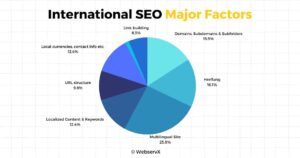
- Customer Reviews.
Customer reviews on your website or local sites can positively or negatively affect your SEO efforts. Better reviews mean better connections with your customers and primary keywords; in turn, it boosts your online visibility.
- Mobile Responsiveness.
The responsiveness of your website for mobile is important and also matters to overall search ranking. As a result, it is worth finding a CDN (content delivery network) capable of providing a top-tier website experience regardless of where users are.
- Google My Business.
Your Google My Business account can help you Boost your SEO efforts so long as you ensure the updates where your country is operating. This is the first step for Google to seek out geographical and language metadata on your website.
- Link Building.
The more links you get from International sources to your site, the better you get results. As we have mentioned before, it is a better idea to write blogs or to connect with influencers to point links back to your website.
International SEO Best Practice.
No matter what approach you take to international SEO, language-focused or country-specific, outsourcing or in-house, this same practice applies to all. Let’s take a look at it.
-
Define your Market approach.
As you know, the SEO strategy that is used in One country would not be appropriate for use in another country. Your business/company and the target audience should be informed of your Strategy.
If you’re selling the same product/service in multiple countries but to people who speak different languages, then you should use a language-based approach strategy.
This means you need to ensure that all the content of your site is translated into all the languages that are important to your business/company.
Your business will need to take a country-by-country approach strategically if its product or services vary across countries/international markets or if it uses a district branding strategy in each country’s local languages. You need to have individual country-specific website optimization for their respective languages/international markets.
-
Do your Market research.
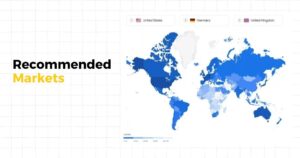
Before starting anything, you should identify the potential market and buyer persona for your product or service and learn about their priorities before implementing an international SEO strategy.
To do this, you should conduct keyword research and investigate different channels through which demographics frequently discover new products. Following that, you’ll get a better understanding of which audience to target and how.
-
Do competitor research.

Analyze your competitors to see how they are doing with SEO, content marketing, and even paid advertising to discover unexpected opportunities; if your competitors aren’t still optimizing their content for specific keywords, markets, and languages, you can start with international SEO for your service or product.
-
Answer the queries in the region’s native language.
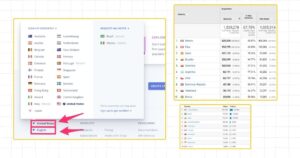
Suppose you ask what is the right way to do Internet marketing properly and one thing to get right for International SEO. In that case, it’s to ensure that you speak the same language as your audience or customer.
So, do your research to ensure that you’re always answering the questions in their native language and the appropriate context.
-
Pick the audience you want to target first.

SEO is not just about keywords and content. It is also about making sure that the entire user experience is processed seamlessly and aligned across your website.
You don’t have to just optimize your content for every country and language at once when it comes to Global optimization. There might be more than one phase to roll out.
To know more about how to conduct International SEO, focus on reaching one additional audience at a time. Gradually, you will understand and learn about International SEO and acquire momentum for Future projects by doing so.
-
Translate and check the existing content carefully.
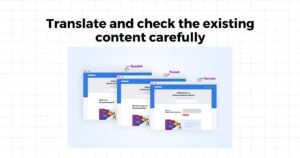
The translation tools sometimes do literal conversion of words and phrases, which are not appropriate, and they’re often not used by the locals. Customers will quickly recognize that there is something that is not quite right!
Instead of translating, you should really look forward to “transcreation.” you need to create the same content but use the culture and language of your target market as a guide.

You must use the appropriate languages for each website page regardless of whether you have chosen a single domain with multiple subdivisions or country-specific subdomains.
This practice will send a strong impression to Google and other search engines about your site’s location-specific relevance of the material, which will eventually increase the likelihood of your site pages ranking high on those products and services.
It also improves the experience of local users, which increases the demand for purchases or revisits.
Targeting the Global audience by adding subfolders with specific pages in different languages of your targeting countries is a good alternative if having a country-specific domain is either impractical or not strategically essential for your business.
-
Avoid automatic redirecting based on the user’s IP address.

However, automatically redirecting visitors or search engines based on IP addresses is quite annoying for the users. Isn’t that so?
It can be quite confusing for the Search engine, too. The visitors may never find specific content. Instead, let the visitor and search engines know about the alternative version of a page.
It seems like a perfect solution, Right? Or either show a banner at the top or bottom of the page with the message and link them to the suggested pages.
-
Choose a Topic that should adapt to local culture.
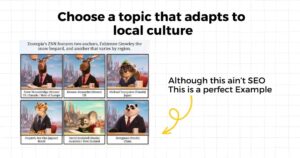
Always reevaluate your country-specific content pertinent to your target audience/local audience. It’s possible, for example, that Australian users won’t be able to find the coverage of American politics or fashions until they are particularly interested in and search for them.
So you should make an effort to deliver content that is particularly relevant and helpful to the user of your demographic audience who visits a specific country site.
The advice is to seek some input from the native speaker of the target language before you start writing or designing anything for the International market.
-
Develop a Link-Building Strategy for each market.

Remember that the value of the link varies based on the point of origin. Google will see all of your content that is relevant to the user if you have a high number of Inbound links from .de domains.
Accordingly, it might adjust your page ranking in the relevant regional SERP(Search Engine Result Page).
Spending a little bit of time developing your strong link-building strategy for each page is beneficial, as local links will have greater value on search engine results.